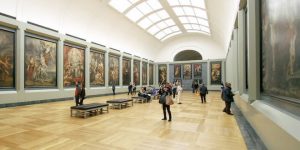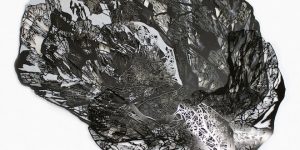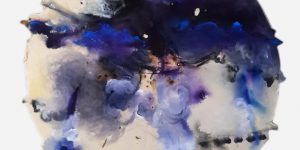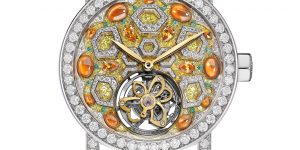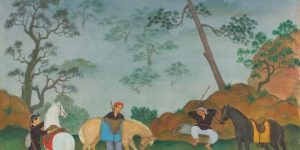Artists from Southeast Asia: Interview with Singapore-born, Brooklyn-based musician Margaret Leng Tan
A look at an illustrious pianist’s life and practice, from her Juilliard days to her one-night only concert, ‘SATIEfaction’, in January this year

Margaret Leng Tan performing ‘SATIEfaction’ at the National Museum of Singapore Gallery Theatre. Image courtesy of the National Museum of Singapore
“More than anything,” enthused Margaret Leng Tan as she sat under the stage lights in the darkened National Museum of Singapore’s (NMS) basement Gallery Theatre, in front of a select group of journalists, “I want to be, not a stand-up comic, but a sit-down comic. And because I use the toy piano, I can be in a position to be funny!” The statement itself seems to be encapsulate the 71-year-old’s spirit — effervescent, curious yet boundary-breaking and iconoclastic — as she conveys her current intentions to “go pop”.
The Singapore-born, Brooklyn-based pianist was at the NMS preparing for a one-night only multimedia concert, ‘SATIEfaction’ on January 20, in a tribute to the late French avant-garde composer Erik Satie, performing both on the grand piano and the toy piano, together with poetry readings and video projections. This was a follow-up on her well-received ‘Cabinet Of Curiosities’ performance at the Singapore International Festival of Arts 2015, where she turned a medley of everyday objects, from chess sets to bicycle horns and alarm clocks, into instruments.
Tan’s list of achievements is dazzling: she was the first Singapore soloist to play Carnegie Hall‘s Isaac Stern Auditorium to a sellout crowd in 2002, has performed at the Venice Biennale on three occasions, and was awarded the Cultural Medallion in 2015, just to name a few. She is also known for being the most important John Cage interpreter, her mentor for 11 years before his death in 1992.

Margaret Leng Tan. Image courtesy of Esplanade – Theatres on the Bay/TributeSG
The provenance for Tan’s illustrious career was apparently borne from a sibling rivalry with her sister (“Everything she did I had to do also and do better.”) and from strong-arming her parents into giving her piano lessons at age six. She subsequently won the open section of the 1961 Singapore-Malaya Piano Competition and then a scholarship to New York’s Juilliard School at the age of sixteen. After her bachelor’s, master’s and doctoral degrees later — the rest is history. Art Republik catches up with Margaret Leng Tan.
What is it about toy pianos that fascinates you, and when did you realise you could create wonders with them?
The toy piano has a magical sound. Because it has metal rods instead of strings, it doesn’t sound like a piano because is really a repackaged glockenspiel pretending to be a one. No two toy pianos sound the same; the rods give off unique, complex overtones. One can sound like the voice of angels and another would work well in the sinister soundtrack to a horror movie. The toy piano can also be nostalgic or serious or funny.
I realised fairly early on that toy pianos and toy instruments are full of potential because with toys there are no rules and the only limit is of your imagination. The toy combinations are endless and when you start adding in other sounding items, well, you are fulfilling what John Cage believed: that you can create music on any object capable of producing sound.
I treat every object I choose to play, be it a toy piano or a bicycle bell, as a real instrument in accordance with French Dada artist Marcel Duchamp’s statement that “poor tools require better skills”. Today, I can say with pride that anything I can do on the adult piano I can do on the toy piano with regard to my control of touch, nuance, articulation and dynamics. I have also worked very hard to finesse my playing technique on the bird whistle or paper accordion so that they too will perform reliably and meet my artistic expectations.
You’ve lost your instruments in transit before, oftentimes retrieved but not always. What is your relationship with them?
It was a nightmare when United Parcel Service lost my 50-pound crate of instruments which has not been recovered to this day. Fortunately, my two top-of-the-line touring toy pianos have always shown up whenever the airlines have been remiss, with the most recent Cathay Pacific debacle early this year, makes a total of 10 incidents over 20 years.
My touring toy pianos are irreplaceable. To me, they are the equivalent of Stradivarius violins — one of a kind in their expressive and virtuosic capabilities. They are my voice. I could never do what I do on any other toy piano.

‘Playing piano at age nine, 1955’. Image courtesy of Margaret Leng Tan
A lot of people know you — if they didn’t already — from your performance of Cage’s silent piece, ‘4’33”’, on your toy piano under a void deck in Tan Pin Pin’s film ‘Singapore Gaga’. How did that come about, and what are your thoughts on that performance?
Pin Pin had contacted me in late 2004, having seen Evans Chan’s documentary on my life, ‘Sorceress of the New Piano’. She wanted to include me and my toy piano in ‘Singapore Gaga’. I think performing John Cage’s ‘4’33”’ under an HDB (Housing Development Board) void deck was a brilliant idea! It captured a slice of Singapore life within that frame of time. As Cage said, “There is no such thing as an empty space or an empty time. There is always something to see, something to hear. In fact, try as we may to make a silence, we cannot. Sounds occur whether intended or not.” I love that bit when a woman walked by engrossed in her mobile phone (even back then!) and did not notice, let alone find it odd that someone would be sitting at a toy piano in a void deck!
What’s important for you when someone experiences your work?
I like to see myself as an entertainer. I want people to have a good time and leave with a smile on their faces. I am not out to prove anything or convert anybody. I am just happy and grateful that they are willing to come down the rabbit hole with me.
Is classical music something intrinsically natural to you and given how it has brought so much to your life, could you have imagined doing anything else?
At this point in time, I feel I have gone beyond classical music into a new genre that transcends boundaries to include not only music in the accepted conventional sense but other sounds as well. Of course when I was a child and during my Juilliard days I aspired to be a classical pianist, like everyone else. But after meeting John Cage in 1981, everything changed. I would say that music is still at the core of my being but it is a music that encompasses the three-dimensionality of theatre, choreography and performance.

‘With Dad, before leaving for NY, 1962’. Image courtesy of Margaret Leng Tan
Your education at The Juilliard School starting at the age of 16 culminated with your Doctorate where you were the first woman to graduate with this degree from the prestigious school. How did your education help mould you as an artist?
The atmosphere at Juilliard is elitist and highly competitive. Some very talented people cannot cope with this. I not only survived but thrived because I discovered there was a great deal to learn not only from my teachers, but from my peers.
To develop your full artistic potential you have to be highly disciplined in your work habits as well as a curiosity about the world around you. Juilliard was essentially a goldfish bowl but I made an effort to escape its confines and partake of the Theatre of Life offered by New York City. What a waste it would have been otherwise!
Your father was the former Straits Times Press chairman, C.C.Tan. Do you feel you came from a creative and intellectually-inclined family growing up? Were there any formative moments growing up that changed and shaped you as an artist?
I come from a family of lawyers. Artistic pursuits were not exactly de rigueur in our household but I was allowed to have music lessons and ballet lessons because my family could afford them, and for that I am grateful.
My father had quite an extensive library and we were encouraged to read. My hunger for books during my formative years has led to an enduring love of the English language and writing which continues to this day. I am proud to say that I have had four articles published in The New York Times.
When I was fourteen, Joseph Bloch, a professor from Juilliard, visited Singapore and heard me play in a masterclass. He encouraged me to consider applying to Juilliard after I finished school. This was a turning point for me: that someone from the outside world thought I was talented enough to seriously consider a career in music.
You first headed to New York in the early 60s when you were just a teenager. What was that transition like?
Before my Juilliard audition I was well looked after by kind friends of friends of my parents. I was dreadfully homesick when I first arrived in New York. Being homesick is one of the most painful experiences I can remember. Then one day I had an epiphany. This was soon after I had been accepted at Juilliard. Driving down the East River Drive in the afternoon with my host family, the sun was glinting on the water and the magnificent New York skyline filled the horizon. Suddenly, I felt a great surge of elation… Here I was in the greatest city in the world, at the best music school in the world! The opportunities in this land of promise loomed large and I was going to make it! All my homesickness fell away at that moment and I never looked back.

‘Juilliard days, 1967’. Image courtesy of Margaret Leng Tan
What is your studio space like and what does it mean to you?
Well, there are three work spaces within my Victorian brownstone: one is the large parlour room upstairs that houses two vintage Steinway grand pianos from the 1890s. I use one piano for prepared piano activities and the other for keyboard playing. Downstairs I have another Baldwin grand piano where I can practice all night since I keep vampire hours.
And then there is the toy piano room which is filled with my collection of over twenty toy pianos along with my arsenal of toy instruments and other sounding objects. These spaces are sanctuaries where I practice, discover, experiment, fail, try again, “fail better”, to quote Beckett, …..all in the company of my wonderful dog companions, my most patient and appreciative audience!
‘SATIEfaction’ comes at a time where you admittedly want to explore a more “pop”, expressive approach to your work — I can’t help but think the attributes oft accorded to Satie — an avant-gardist and a visionary… disregard for the rule book… and his embrace of the absurd and the surreal and the blurring of high and low art — may as well be about you.
Wow, that’s really generous! I won’t let it go to my head! Those attributes that you mentioned I feel are truly applicable to John Cage and Marcel Duchamp, both great and influential artists. John was a close friend of the older Duchamp, they played chess together regularly. Duchamp’s revolutionary ideas about art, as enshrined in his “readymades“, had a profound impact on Cage. I would go so far as to say that Cage’s ‘4’33”’ is a “musical readymade”. There is definitely a connection to Satie’s idea of “Furniture Music” which was intended as wallpaper or background music.
So you see, all the stuff that I do using toys and everyday objects is merely the logical endgame to a trajectory charted by these brilliant visionaries who came before me.

Margaret Leng Tan performing ‘SATIEfaction’ at the National Museum of Singapore Gallery Theatre. Image courtesy of the National Museum of Singapore
What’s coming up in 2017 for you? You have mentioned the revered George Crumb has been composing a new work specially for you.
Yes, the iconoclastic American composer George Crumb, who is now 87, has just completed ‘Metamorphoses, Book I’, the first instalment in a new major piano cycle, his first since his creation of the groundbreaking ‘Makrokosmos’ series in the 1970s.
I will never forget when he casually mentioned in July 2015 that he was going to write this for me and that each of its ten movements would be inspired by a different painting. What a gift!
For the past year and a half I have had the great privilege of being Crumb’s pianistic muse. I realise that this is history in the making. It has generated quite a buzz and many festivals are interested to present it. It will be the focus of my performance schedule for 2017 and 2018.
What’s the end goal?
From John Cage I have learnt to regard both life and art as processes unfolding inexorably in their own time. Within this, goals become irrelevant. I will continue to work as long as the ideas keep coming and as long as I am physically and mentally capable.
From a broader perspective, I hope that I have given a new generation the confidence to seek and persevere on their individual creative paths and to remain strong in the face of skepticism and criticism.
This article was originally published in Art Republik 14.




